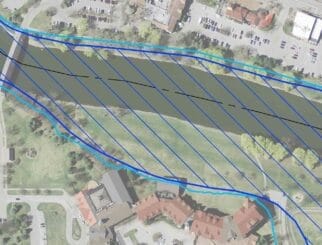Michigan Central Train Station 3D Scanning
Spalding DeDecker (SD) was commissioned to prepare a boundary survey using laser scanning technology for property acquisition adjoining the Detroit Central Train Station. Canadian Pacific requested SD to locate the property lines, all visible improvements and utilities including fencing, railroad tracks, bungalow switch buildings, utility markers, fiber optic lines and map the underground train baggage area.
The Project
SD’s laser scanning crew obtained over 4 billion coordinate points creating an accurate point cloud used to locate and map the baggage area of the historical building. Our survey crews scanned the baggage area columns to define the location of the new property lines. Defining the property lines determined the new parcels and which land would be purchased by Ford Motor Company.
The Challenge
Below the tracks laid the crumbled remains of the train station’s baggage area, which was abandoned since the winter of 1988. The baggage area was in poor condition and was unsafe. However, using laser scanning allowed our crews to minimize the number of crews and reduced the amount of time in the area increasing workers safety. Using laser scanning technology is a safer, more cost-effective method than traditional mapping, and results in a more accurate survey. Our crews went inside the old structure and scanned the columns holding up the building
The Solution
Generating a point-cloud allowed generated a highly detailed reality capture of the facility, and made it easier for clients from across the world to view the proposed division lines as if they were there.
The Impact
In the summer of 2018, the building was purchased by Ford Motor Company and is now undergoing a complete historical renovation. The point cloud was delivered to our client and Ford Motor Company by email. A link to the Leica TrueView program was provided for them to see the proposed location of the property lines in a 3D view. A conventional/ 2D view was delivered based on the agreement of both parties using the 3D point clouds. As more excess property lines defined, the City of Detroit will add more land to their tax roll. Thus, resulting in larger revenue for the City.


